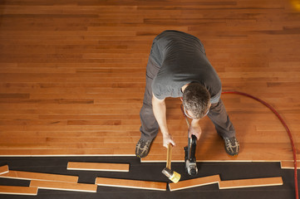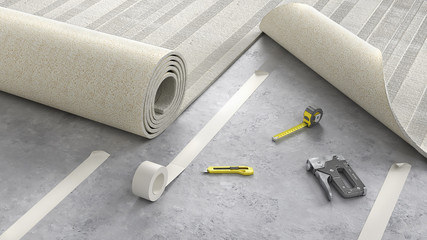Benefits of Hardwood Flooring
Flooring Fairfield NJ is timeless, adding elegance and value to homes. They also offer a host of benefits, including being hypoallergenic and helping to improve air quality.
When choosing hardwood, consider its hardness. Softer species, such as pine, tend to show scratches more easily. Harder species, like oak, hold up better. Also, choose a stain and varnish that are low-VOC and GREENGUARD-certified for indoor air quality.

Hardwood floors are a statement of elegance that will never go out of style. They pair beautifully with almost any decorative theme. And, they’re especially well suited to complement the modern trend toward natural materials like stone and finished concrete.
There are more than 50 different hardwood species, each with its own distinctive coloration and graining pattern that will provide a one-of-a-kind look for your home. In addition, you have a number of finish options to choose from that will affect the overall appearance.
For example, hickory is known for its light color and bold, straight-lined grain pattern that works well in traditional or contemporary homes. Oak is also popular for its classic, smooth look that works well with many design styles. And, walnut has a unique coloration that combines brown tones and dark highlights in the graining for a rich floor. Similarly, Brazilian teak is an exotic wood species that’s known for its tan to medium brown coloring and reddish highlights in the graining.
When choosing a hardwood flooring color, you will want to consider the brightness of your room and how it might be affected by sunlight. Do you prefer a darker tone that will warm up a bright space, or do you favor a lighter color that will open up your home and let in more sunlight?
You will also need to decide whether you prefer a smooth or textured surface for your wood flooring. Smooth finishes create a modern, sleek appearance, while wire-brushed and distressed woods have a more rugged and characterful appeal.
Over time, your wood floors will develop its own character as they age, absorbing subtle shadings and picking up small scratches and nicks that add depth and personality to your floor. This unique personality is further enhanced when you choose to incorporate plank or parquet hardwood installations.
Wood flooring is a great choice for large spaces because it has a natural texture and patterning that can help to add visual interest and warmth to a room. It’s important to note, though, that there are wood species that are better suited to smaller rooms than others. For instance, ash and walnut have a lighter color that makes them ideal for smaller rooms. Also, modern grades that have minimal to no color variation and knots are available for those who need a more uniform aesthetic for their room.
Hardwood floors are not only beautiful, they’re also extremely durable. This is due to both the density of the wood and the type of finish used. The harder the species, the more resistant to scratches and dents it will be. Harder woods include oak, maple, hickory, and walnut. The softer woods include pine and cherry. These are less durable, but can still be used in areas with light traffic. When choosing your hardwood flooring, it’s important to consider your lifestyle and design vision. Some styles and colors may be more prone to showing marks from heavy foot traffic, while others will hide these markings better.
One of the biggest decisions you’ll have to make is whether you want solid or engineered hardwood flooring. Solid hardwood floors are made of one solid piece of wood from top to bottom, while engineered floors are layered together with a solid piece of wood on top. Solid hardwood is more durable, but will have a higher price tag than engineered flooring.
When shopping for hardwood, you’ll also need to choose your color and grain pattern. Grain patterns are a great way to add visual interest to your floor. They can range from wide, dramatic tones of exotic woods to tight, nutty brown shades of domestic oak. Different colors and grain patterns can help mask dents and scratches as well. Lighter to mid-toned hardwood floors will show markings more than darker and richer colors.
A good way to determine how durable your hardwood will be is by looking at its Janka hardness rating. The Janka hardness test is a standard way to measure how durable a wood species is, and it measures how much force is needed to push a steel ball halfway into the wood. The higher the Janka hardness number, the more durable the wood. Exotic woods tend to have the highest Janka ratings.
Besides picking the right hardness level, you’ll need to decide between an oil-based or water-based finish. An oil-based finish will penetrate the wood pores and protect it from the outside elements, while a water-based finish will sit on the surface of the wood. Oil-based finishes are more durable and last longer than water-based ones.
Whether it’s a modern or traditional home, hardwood floors create a warm and authentic look that can complement any style. They add a natural beauty that increases the value of your home while making it more attractive to prospective buyers. Wood flooring also introduces Biophilic Design into your living space, which is based on the theory of humans’ innate love of nature and its processes.
Hardwood floors are easy to maintain. Sweeping or vacuuming regularly can remove dust, dirt and other debris that could damage your finish over time. This prevents minor scratches and dents from pets or heavy foot traffic. It’s also possible to refinish your hardwood floors over the years to keep them looking new.
Many homeowners choose to replace their carpeting with solid or engineered hardwood flooring in their homes. This upgrade is a great way to add style and value to the home, but it’s important that the floor soundproofing plan is implemented properly as well. Without a proper soundproofing solution, the impacts from footsteps on the hardwood will travel through the layers of plywood or concrete to the rooms below and cause an excessive amount of noise. This can be easily solved by adding an underlayment to reduce impact noise.
There are several different types of underlayments that can be used with hardwood floors, including foam, cork, or rubber. They all work to reduce both airborne and structure borne sound, but they are best utilized in a complete floor assembly that includes a floating floor, acoustic channels, multiple layers of drywall, and batt insulation in the joist bays.
Another solution is to use specific furniture that can help dampen the vibration of sounds. For example, upholstered pieces such as sofas and chairs can reduce the level of noise that is produced by walking on wooden floors. Slippers and socks can also reduce the amount of noise caused by wearing shoes on wood flooring.
As a builder or contractor, it’s crucial to educate your clients about the importance of a soundproofing plan for their wood floors. If your client is planning to sell the house in the future, they will likely want to install a higher quality of flooring that will add value to their home.
Hardwood flooring can add a touch of luxury and elegance to any home. It can also be a good choice for people with allergies as it does not trap dust, animal dander or other common allergens like carpet does. It’s easy to improve your home’s indoor air quality with hardwood floors.
Carpeting can trap these allergens and make it hard to clean, but hardwood floors are easily disinfected and will not harbour bacteria or unpleasant odours. This makes wood a great choice for kitchens where food and drink are often served.
Another benefit of hardwood floors is that they help to increase the value of your home. This can be important if you are thinking about selling your house in the future. Buyers prefer hardwood floors over carpets because they are easy to clean and maintain.
Wooden floors are available in many different styles, so you can choose a look that suits your personal aesthetic. They are timeless and can enhance any type of home. You can find a range of colors, grains, and species to fit your style. There are even exotic and rustic styles that can add a more unique touch to your home.
There are two main types of wooden floors: solid and engineered. Solid wooden floors are planks of milled timber that have been cut from a single log. They are then stained and sealed to protect them from moisture, dirt, oil and other grime. The alternative to this is engineered wooden floors, which are made from layers of different hardwoods glued together and then covered in a layer of laminate.
Both types of wooden floor are durable and long-lasting but if you want yours to last then there are a few things you can do. Always sweep your wooden floors regularly and use a broom with a soft brush to remove dust from the surface. Avoid using abrasive cleaners or chemicals, as these can damage the surface. If you have children or pets, then it may be a good idea to place rugs over the hardwood to prevent scratches and spillages.

